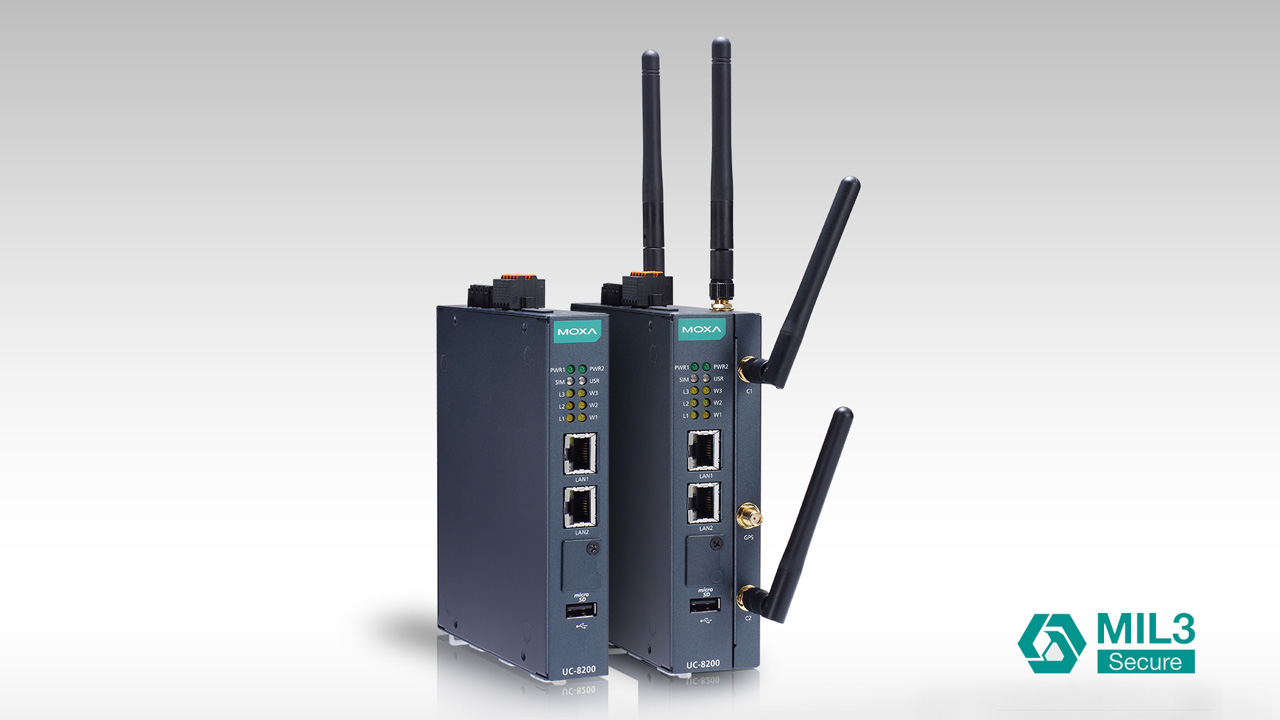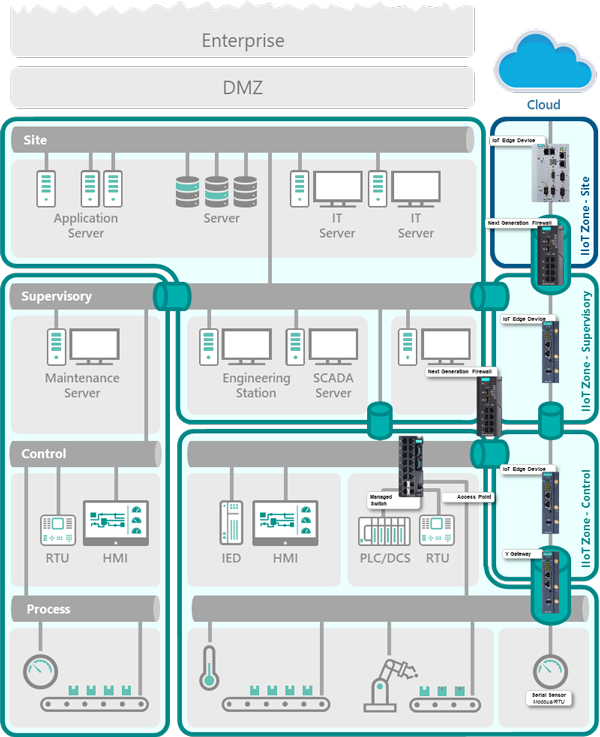TechnologyAugust 2, 2023
Emergence of edge and cloud computing enabled by IEC-62443

The adoption of IEC-62443 is set to play a crucial role in enabling digital manufacturing and will have a significant impact on the realization of Industrial IoT, leading to improvements in quality, output, and reduced downtimes.
Industrial edge and cloud computing offer a host of specific technical benefits that have the potential to significantly impact the manufacturing.
Philipp Jauch, Business Development Manager, Industrial Automation for Moxa Europe GmbH, explains how IEC-62443 plays a key role in enabling digital manufacturing along with addressing scalability and security challenges.
What are key technology trends that enabling the emergence of Industrial Edge and Cloud technologies?

The integration of edge and cloud computing creates innovative system architectures that create unique benefits for supervisory, control and process automation. One primary advantage is scalability. By leveraging industrial edge and cloud computing, manufacturers can achieve scalable solutions that adapt to their evolving needs.
The emergence of Industrial Edge and Cloud technologies is being driven by several key technology trends. One of the significant breakthroughs is the adoption of IEC-62443, which plays a crucial role in enabling digital manufacturing. Previously, the ISA-95, also known as the Automation Pyramid, was designed with a focus on security. Data was aggregated at each level and communicated between the levels above and below, following a functional approach. This rigid mode of communication, while secure, has been a bottleneck for digital manufacturing.
In the pursuit of easier data access, compromises on plant security were often made. However, IEC-62443 provides innovative ways to maintain security while simultaneously improving data accessibility and flexibility across all existing layers of the ISA-95. This includes facilitating horizontal communications with new devices and services implemented in the manufacturing process.
The implementation of IEC-62443 will have a significant impact on the realization of Industrial IoT, leading to improvements in quality, output, and reduced downtimes. By striking a balance between security and accessibility, this technology trend accelerates the integration of Industrial Edge and Cloud technologies, driving digital transformation in the manufacturing sector.
What are the specific technical benefits the industrial edge and cloud computing provides, and its potential impact on manufacturing?
Industrial edge and cloud computing offer specific technical benefits that have the potential to significantly impact the manufacturing industry. However, there are challenges that need to be addressed to fully realize these benefits.
One of the primary advantages is scalability. By leveraging industrial edge and cloud computing, manufacturers can achieve scalable solutions that adapt to their evolving needs. This allows for efficient utilization of resources and improved operational flexibility.
Standardization is another key benefit. The adoption of technologies such as IEC-62443, OPC UA, and MQTT facilitates the establishment of secure industrial networks with proven designs. These standards enable seamless integration of logical connections throughout entire plants, reducing vendor lock-ins and promoting interoperability.
The utilization of smart and affordable industrial IoT gateways deployed close to the applications in the manufacturing environment, along with the use of new types of sensors, enhances data exchange and enables real-time monitoring and control. This improves overall efficiency, quality control, and predictive maintenance capabilities.
The impact of industrial edge and cloud computing on manufacturing is substantial. It enables manufacturers to access and analyse large volumes of data, leading to data-driven decision-making and process optimization. This, in turn, enhances productivity, reduces downtime, and improves product quality.
Furthermore, the adoption of these technologies opens new possibilities for collaboration and connectivity across the supply chain. Manufacturers can leverage cloud-based platforms to connect with suppliers, customers, and partners, fostering innovation, streamlining operations, and enabling faster time-to-market.
Provide readers a technical description on what makes this technology unique, and how it is being applied to industrial applications.
This technology’s uniqueness lies in its establishment of the Industrial IoT zone and its application in industrial settings. The IIoT zone is created by identifying relevant assets and network connections. At its core is the IIoT gateway, serving as the primary asset and providing connectivity to the Internet during deployment.
A notable feature is the use of zero-touch provisioning for IIoT gateways. These gateways come pre-configured and are enrolled in the customer IoT Hub’s allowed devices list. During physical installation, technicians simply connect power and LAN cables, and the devices automatically connect to the Cloud, receiving complete configuration details. Post-installation, software modules within IoT Edge can be deployed and modified.
Once the IIoT gateways are Internet-connected, Cloud-based management becomes possible through Device Lifecycle Management (DLM), a vital aspect of modern IIoT infrastructure. Ideally, the IIoT zone should be established prior to gateway installation, involving a LAN port on a local switch with a VLAN routed to the Internet.
For multiple IIoT gateways in different network zones, like nested Edge Architecture, similar procedures establish conduits between the gateways/IIoT zones, permitting MQTT traffic exclusively. Southbound connectivity is set up, including the configuration of firewall rules, especially for Ethernet-based data sources.
In summary, this technology’s uniqueness stems from its IIoT zone establishment and its application in industrial settings. Zero-touch provisioning, Cloud-based management, and proper connectivity enable seamless integration and control of IIoT gateways, facilitating efficient data exchange and management in industrial applications.
What specific application areas are the newest Industrial Edge and Cloud solutions targeting? How are these solutions contributing to IoT and enterprise connectivity?
The newest Industrial Edge and Cloud solutions are targeting various application areas, contributing significantly to IoT and enterprise connectivity. These solutions address the need for secure connectivity between assets in different zones within the OT environment. By utilizing different types of conduits, such as industrial firewalls, VLANs, and IDS/IPS systems, the automation network management team establishes secure communication channels.
Industrial firewalls play a crucial role in controlling packet flow between devices on different ports. With granular configuration options, they enable specific types of packets to be allowed or prohibited, ensuring efficient communication. Additionally, next-generation firewalls inspect packet contents, providing fine-grained control over protocols and command types.
VLANs, when combined with firewalls, create isolated network segments. This allows for secure routing of communication between IIoT gateways and the Cloud, keeping IIoT traffic separate from other network traffic. This additional layer of security enhances the overall connectivity and protection of the system. Intrusion detection/prevention systems (IDS/IPS) go beyond controlling packet flow by monitoring network traffic for potential intrusion events. These systems detect patterns associated with known vulnerabilities or exploits. By utilizing IDS/IPS systems, the automation team can connect devices that would typically be kept separate, reducing risk while maintaining security.
By incorporating these cutting-edge solutions, the automation network management team establishes secure connectivity in areas such as industrial automation, energy management, and smart infrastructure. These solutions contribute to the advancement of IoT and enterprise connectivity by enabling efficient and controlled communication, reducing risks, and ensuring the smooth operation of critical systems within the OT environment.
What are challenges that automation engineers face that these advances in edge computing and/or cloud computing addresses?
Automation engineers encounter various challenges when introducing new infrastructure, and the advancements in edge computing and cloud computing effectively address these challenges.
Productivity is a key concern in the OT environment, as uninterrupted operations and timely issue resolution are essential. To minimize disruptions during the integration of new IIoT zones and Edge infrastructure, careful planning, phased rollouts, thorough network assessments, parallel testing, and contingency plans are crucial. By ensuring a smooth transition and avoiding interruptions, productivity can be maintained, directly impacting financial losses.
Reliability becomes a significant concern when new devices interact with existing PLCs and Control Systems. Rigorous testing and validation processes are necessary to ensure compatibility, performance, and reliability. Conducting comprehensive tests, addressing conflicts or issues, and implementing backup systems or redundancy measures mitigate risks and promote reliable operation.
Safety always takes precedence in any changes made to the OT environment. Comprehensive risk assessments and safety measures are vital to identify potential risks associated with new devices or protocol changes. Regular review and updates of safety protocols and emergency response plans ensure timely responses to life-threatening situations.
Interoperability is a critical challenge in complex environments with diverse subsystems and data sources. Establishing a common operating environment using standard protocols, data models, and interfaces facilitates seamless integration with other systems, such as the Cloud or Edge infrastructures. By adopting industry standards and best practices, effective communication and efficient data sharing can be achieved, enhancing overall system efficiency.
By addressing these challenges related to productivity, reliability, safety, and interoperability, the advances in edge computing and cloud computing enable automation engineers to successfully introduce new infrastructure while maintaining optimal OT operations.


